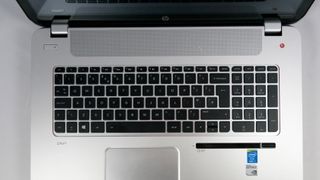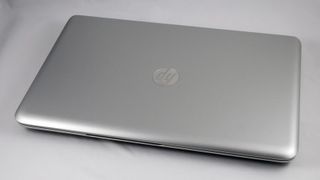Why you can trust TechRadar
When we said HP wasn't just relying on the Leap Motion controller to make this machine desirable, we weren't kidding. Just look at the benchmarks! Well, not the battery one, because it's terrible, but the others are great.
The quad-core Intel Core i7 processor produces a great score in our Cinebench tests, though we should point out that it's marginally lower than the 6.58 achieved by this machine's little brother, the HP Envy TouchSmart 15 – though that's not real surprise, since the CPU in this one is clocked marginally lower. The difference is negligible, but the TouchSmart 15 is a few hundred pounds cheaper these days, so it's not nothing.
Benchmarks
- Cinebench: 11.5; OpenGL: 52.68 fps; CPU: 6.34 points
- 3DMark: Ice Storm: 57772; Cloud Gate: 8800; Fire Strike: 1541
- Battery Eater Pro: 70 minutes
However, the Envy Leap Motion laptop is comfortably ahead of the TouchSmart when it comes to graphics performance, veritably trashing its scores for the 3D Mark tests. In the Fire Strike test, it outscored it by 50%, thanks to its beefier Nvidia GeForce 750M graphics and 4GB of video RAM.
However, looking at this laptop's place in the larger scheme of things, it's not as clear cut. The Medion Erazer X7825 costs slightly less than this laptop, but offers a stronger CPU and GPU combination, and actually doubles the Envy Leap Motion's 3D Mark Fire Strike test score, despite having less video RAM – it's graphics are just hugely better elsewhere. The CPU also scores higher, but only by a small amount.

However, HP's secret weapon for some high-end applications here is the 12GB of RAM its packed in. That's generous beyond what any home user needs, really – sure it's always nice to have RAM, but for casual use, you generally won't find yourself struggling with 8GB.
So yes, it's pretty clear that HP has its sights set on this being a professional creative machine. However, it again takes a little bit of a back seat to HP's Envy TouchSmart 15, which offers 16GB (!) of RAM for less money.
This is only really an issue if you're doing some pretty high-end creative work, though. Even for regular Photoshop users or HD video editors, 12GB is fine. It's not really something that makes the TouchSmart 15 obviously better than this Envy Leap Motion for most people, but it's worth considering.
One area that this machine does get one up on its little brother, though, is the screen. It's larger, at 17-inches, but is still 1920 x 1080 Full HD. However, it offers great viewing angles and general image quality, beating even the (also 17-inch) Medion Erazer in this respect.
Colours look good, everything's nicely detailed and viewing angles are all superb, though we will say that it appears to have a slightly blue colour cast – for professional work, it's worth noting this. For most people, it's no problem at all, though – well within the norms that your eye just adjusts for when going from screen to screen.
Of course, the screen needs good viewing angles, because when you're using the Leap Motion controller, you end up moving around a fair bit.

Though the sensor strip is on the right of the machine, you can move your hand over the whole width of the laptop to control things on-screen. Well, we say "control things", but what we mean is "control compatible apps".
You can't just start instantly flicking through Windows 8 with a wave of your hand, which is a shame, because it would quite suit the tile-based UI, actually. But once you run the Leap Motion Airspace suite, you can play around in games and various other apps.
The thing is, though… it's not great. The simple visualisation stuff is awesome – seeing neon skeletons of your hands, and waving your way through abstract images is good fun for a while. But whenever you get into a game or useful app, you will start to need precision, and that just isn't happening.
It's a bit like the early raft of third-party Wii games. Nintendo made simple early games that couldn't go wrong, but when everyone else jumped on board, the results were often far too clumsy for the controller. And it feels like that with the Leap Motion.
Dropchord is probably the best-performing of the games, thanks to not needing that much detail in your movement, but still glitches around. Others can just feel futile, ultimately, and things like the painting tools just seem miles away from true usefulness. Not only is precision with your finger movements almost impossible with nothing to offer resistance, but the balance between how close you have to hold the finger to draw and how close you have to hold it to just move the cursor is so hard to maintain.
The funny thing is, the HP Envy Leap Motion has a touchscreen. And a lot of the gesture-based stuff could be achieved on it with less frustration. Leap Motion is cool, but unless it's implemented in the most basic (and, arguably, gimmicky) fashion, it felt superfluous to us.

Even ignoring the Leap Motion, though, this isn't at the head of the pack for general usability. The trackpad seems to sometimes have issues registering clicks totally consistently – a problem we found with the HP Envy TouchSmart 15, too. Occasionally – and too often – we'd find ourselves trying both tapping-to-click and actually clicking to little effect. Then it would be fine for a while. Funnily, though, we also found ourselves accidentally choosing things at time when we were just trying to move the mouse. For a machine costing over £1,000, it could be pretty frustrating.
The keyboard has some flex under it that's rather irritating, too, but also the keys are just very spongy. These two factors combine to make it rather poor for feedback, though in terms of size and spacing, it's perfectly fine.
There are two other disappointments for the HP Envy Leap Motion, though. First is the hard drive, and though we certainly don't turn our nose up at 1TB of storage in a laptop, we aren't so pleased about the lack of an SSD in what is otherwise a fairly high performance machine.
Microsoft's general optimisations to Windows 8 means it's not so onerous for booting and waking the machine from sleep as it once was to not have an SSD. But if you want to use this for games (as well you might) or other tasks involving large files (like lots of creative apps might involve), it's definitely a speed hit. Still, the trade-off is storage size for storage speed at the moment, so you might prefer the size here.
What's just straight-up poor is the battery life, achieving just 70 minutes in our Battery Eater test. This doesn't have to be the end of the world, since our benchmark is intensive, and perhaps you'll only use it plugged in for gaming or Photoshop/video editing/whatever work.

If you're using the HP Envy Leap Motion for lighter work, you'll get better, of course. Writing this review in Google Docs, so just typing and using the internet, the battery life was more like four hours on a charge.
Still, if what you want is a balance of power and longevity, you're far better off looking at Apple's MacBook Pro 15-inch with Retina display, which will double that battery life for light usage (for more money, admittedly).
A quick note has to go the Beats Audio speakers, which offer some serious loudness, but without the distortion you get from a lot of built-in speakers. You even manage to get some decent stereo separation out of them when sitting square on. They're broad, fairly deep, and a welcome addition.

